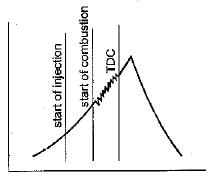Test: Combustion & Combustion Chambers Of IC Engine - 3 - Mechanical Engineering MCQ
20 Questions MCQ Test Topicwise Question Bank for Mechanical Engineering - Test: Combustion & Combustion Chambers Of IC Engine - 3
An engine using octane air mixture has N2, O2, CO2, CO and H2O as constituents in the exhaust gas. Which one of the following can be conceded?
Knocking in spark ignition engine can be reduced by
The ignition of the charge by some hot surface within the engine before the passage of spark is called
For minimizing knocking tendency is SI engine, where should be spark plug be located?
The delay period in Cl engine depends upon which of the following?
The tendency of knocking in LC. engine reduced by
Increasing the compression ratio in Si engines the knocking tendency
Decreasing the cooling water temperature in SI engines, the knocking tendency
Detonation in SI engines occur due to
Desirable characteristics of the combustion chamber for SI engines to avoid knock is
In Cl engines with increase in compression ratio the delay period
Knocking takes place in Cl engines
In Cl engines knocking tendency increases with
In Cl engines by increasing inlet air pressure the knocking tendency
In Cl engines the delay period is affected by
Match List-I with List-Il and select the correct answer using the codes given below the lists:
List-I
A. Cetane number
B. Approach and range
C. 
D. dh = cpdT, even when pressure varies
List-II
1. Ideal gas
2. Van der Waals gas
3. SI engines
4. Cl engines
5. Cooling towers
6. Heat exchangers
Codes: A
A B C D
(a) 1 2 3 4
(b) 1 2 4 5
(c) 4 5 2 1
(d) 5 4 1 2
Which one of the following action(s) increase(s) the knocking tendency in the SI engine?
Which of the following feature(s) is/are used in the combustion chamber design to reduce SI engine knock?
Which of the following factor(s) increase(s) the tendency for knocking in Cl engine?
A diesel engine is usually more efficient than a spark ignition engine because
|
45 videos|314 tests
|




















